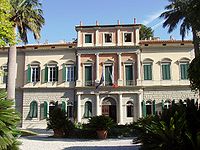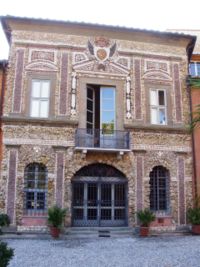
Orto botanico di Pisa
Encyclopedia



Botanical garden
A botanical garden The terms botanic and botanical, and garden or gardens are used more-or-less interchangeably, although the word botanic is generally reserved for the earlier, more traditional gardens. is a well-tended area displaying a wide range of plants labelled with their botanical names...
operated by the University of Pisa
University of Pisa
The University of Pisa , located in Pisa, Tuscany, is one of the oldest universities in Italy. It was formally founded on September 3, 1343 by an edict of Pope Clement VI, although there had been lectures on law in Pisa since the 11th century...
, and located at via Luca Ghini 5, Pisa
Pisa
Pisa is a city in Tuscany, Central Italy, on the right bank of the mouth of the River Arno on the Tyrrhenian Sea. It is the capital city of the Province of Pisa...
, Italy
Italy
Italy , officially the Italian Republic languages]] under the European Charter for Regional or Minority Languages. In each of these, Italy's official name is as follows:;;;;;;;;), is a unitary parliamentary republic in South-Central Europe. To the north it borders France, Switzerland, Austria and...
. It is open weekday mornings without charge.
The garden was established in 1544 under Cosimo I de' Medici
Cosimo I de' Medici, Grand Duke of Tuscany
Cosimo I de' Medici was Duke of Florence from 1537 to 1574, reigning as the first Grand Duke of Tuscany from 1569.-Biography:...
as the first university botanical garden in Europe, and entrusted to the famous botanist Luca Ghini
Luca Ghini
Luca Ghini was an Italian physician and botanist, notable as the creator of the first recorded herbarium, as well as the first botanical garden in Europe....
of Imola
Imola
thumb|250px|The Cathedral of Imola.Imola is a town and comune in the province of Bologna, located on the Santerno river, in the Emilia-Romagna region of north-central Italy...
. In 1563 the garden was relocated from its original riverside location (now the Medicean Arsenal) to one near the convent of Santa Marta, and in 1591 again moved to its third and current location. From these early times, the garden has contained a gallery of natural objects (now Pisa's Museo di Storia Naturale), a library (now part of the university library), and portraits of its directors throughout the centuries. It also includes one of the earliest iron-framed hothouses built in Italy.
Today the garden is divided into sections containing the botanical school, gardens, ponds, greenhouses, and various buildings. Major collections include herb gardens and arboreta, as well as the old botany institute, built 1591–1595, with a facade ornamented with sea-shells.

